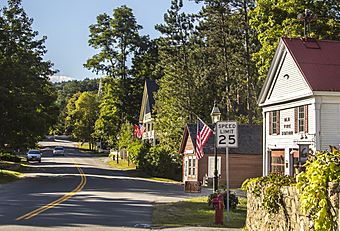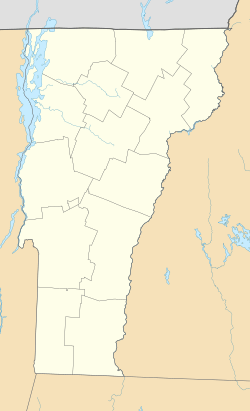Grafton Village Historic District facts for kids
Quick facts for kids |
|
|
Grafton Village Historic District
|
|

Main Street
|
|
| Location | Main St., Vermont Route 121 E., Townshend Rd., Chester Hill Rd., Hidder Hill Rd., Pleasant St., School St., Middletown Rd., and Hinckley Brook Rd., Grafton, Vermont |
|---|---|
| Area | 287 acres (116 ha) |
| Architectural style | Federal, Greek Revival |
| NRHP reference No. | 10000171 |
| Added to NRHP | April 7, 2010 |
The Grafton Village Historic District is a special area in the town of Grafton, Vermont. It includes the historic center of the village. This area was mostly built in the early to mid-1800s. It still looks a lot like it did back then, more than many other small towns in Vermont. Because of its unique history and preserved buildings, this district was added to the National Register of Historic Places in 2010.
Contents
Discovering Grafton Village's History
How Grafton Village Began
The land where Grafton is now was first set aside in 1754. But people didn't start living there for good until the late 1770s. The village of Grafton grew up where two parts of the Saxtons River meet. This river eventually flows into the Connecticut River.
The very first house in the village was made of brick around 1795. It was built by a person named Enos Lovell, and it is still standing today! After that, mills and dams were built on the rivers. These mills helped the town grow, though only small parts of them remain now. The main roads that lead out from the village also started to form around this time.
The Village Center Grows
At first, most of the buildings were around Kidder Hill Road. But in the early 1800s, the village center slowly moved north. This shift happened when the Congregational Church was built in 1834. Also, the post office moved into what is now the town hall in 1841.
Grafton's busy building and economic times slowed down around 1870. Not much new construction happened for a long time. Then, in the 1900s, tourism became very important. This helped the town's economy a lot. With more visitors, people also worked hard to preserve the village. This effort helped keep Grafton looking like it did in the 1800s.
What Makes the District Special
The historic district covers almost all of the developed area of Grafton village. Its edges are generally the two parts of the Saxtons River. It also stretches a bit along roads like Chester Road, Route 121 East, and others.
Many buildings in the village show styles from the 1800s. These include the Federal and Greek Revival styles. Some newer buildings from the 1900s are also built in styles that match the older ones. Most buildings are made of wood and are one to three stories tall. However, there are also many brick buildings. You can also see some Italianate and later Victorian styles.
It's amazing how few of the old buildings have been changed in ways that don't fit. For example, you won't see many with plastic siding or new vinyl windows. The streets also look very old, without many modern things like lots of power poles.
Important Buildings in the District
Six buildings or places within the district are so special that they are listed on the National Register of Historic Places by themselves.
- The Kidder Covered Bridge is the only covered bridge left in Grafton.
- The Butterfield House is now the town's library.
- The Milldean and Alexander-Davis House are two houses known for their beautiful architecture.
- The Grafton Congregational Church and Chapel is important for both its design and its role in the community.
- The former Grafton Post Office is also significant for its history and architecture.
- The Grafton District Schoolhouse No. 2 is important for its history as a school and its design.



